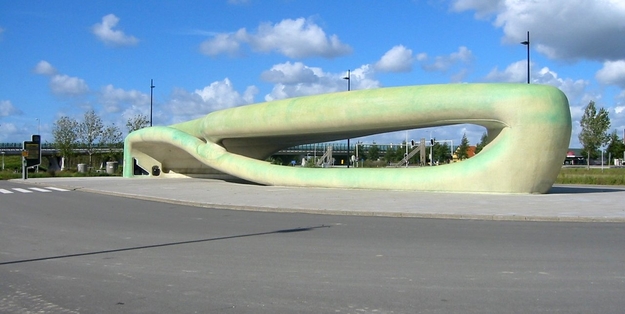There are hundreds of reasons to choose for the new virtual world with its advanced and subtle fractional technologies, but at the same time there are just as many reasons to choose for the old real world because of its slow and stiff mechanical methods. However, a principal choice for one of the two worlds is actually hardly fascinating. Just like in the stories of William Gibson, the only thing that is interesting is the borderline and interaction between the real and the virtual. The trick is to stay somewhere in between the real and the virtual, the dogmatic and the ambiguous, the organisation and self-organisation, the stable and the unstable, the straightforward and the curved, the hard and the soft, the crystalline and the liminal.
The problem is how to do that in a natural way without being to conscious of it. A principal choice for one of the two worlds is not only simplistic but also disastrous. It is like having to choose between the literal and the metaphorical, because that is really what this choice is all about. Should a designer, and the architect in particular, choose for the literal virtuality of a model that is made by a computer or should he choose for the metaphorical virtuality of a conventional model? This question is senseless because it is the borderline between the two design processes that is interesting.
There are people that keep on pointing at particular areas in which the virtual space already plays a big role such as the aircraft industry or information technology. On the other hand, however, one could also point at the charms of the real space that is threatened to become a vacuum of the technocratic mentality, the design loss of the advanced design techniques, the third world of the virtual white empire, the desert of the digital transparency.
If I would be an army officer I would choose for the virtual world without batting an eyelid, because I would be able to control the world, which is always in war, by means of non-euclidic geometry. As an architect however, I find such a choice too technocratic and simply too limited. I prefer the obscure ways of unfathomed decisions to design. Take for example the architecture of Frank Gehry and Daniel Libeskind. The first is known for his complex and computerised architecture, but in reality he works in the old-fashioned way with clay scale models that are later made into three-dimensional models by his staff. This is shown by his designs, such as the Museum of Contemporary Music in Seattle, which is an ode to Jimi Hendrix. When he started to design this building Gehry said to the client: This is not my thing, I listen to Haydn. The massive stiffness of a solo idea which is intelligently translated into architecture by advanced programmes. It is the ugliness and the clumsiness of Gehry's designs that are touching compared to the smooth pretentions of the present generation of computer fetishists. The other side of the coin is represented by Daniël Libeskind's intellectual designs. Libeskind is the guru of the metaphorical and cabbalistic architecture. He makes personal and inimitable constructions that are, just like Gehry's projects, deaf to the chat of curved surfaces and soft lines.
By the way, why is the virtual space only restricted to architecture and why is town planning still an underdeveloped discipline in this area? This is probably because town planning has to do with politics and thus with the delays of the consensus, whereas architecture sometimes has the advantage of being confronted with the individual belligerence and idiosyncratic ideas of a client. This is the only reason why the virtual empire has more grip on architecture than on town planning.
In order to overcome this deadlock it is necessary to have an idea what the roughness of the mechanical world can mean within the smooth universe of a world that is made by computers. As an architect one has to deal more cunningly with urban development (read: mechanical and euclidical) questions. Imagine having to make an architectural proposition within an urban development whole. One could easily get lost in the specified and obligatory preconditions and one could get lost in trifling and yet highly advanced and enthusiastic workmanship on the computer. One could also try to make the rough reality penetrate into the union of powers of the willingly virtuality (the reversed is also possible). It is like surrendering oneself to the revenge of the vacuum. The revenge of reality.
That is my dream. To infect the soft with the hard. The liminal with the crystalline. The virtual with the real. The clever with the stupid.
